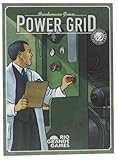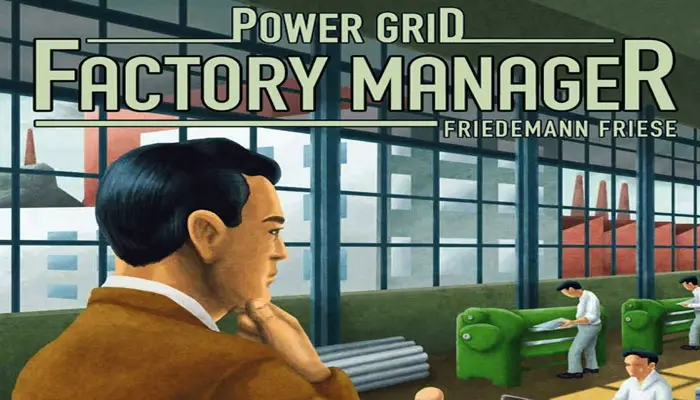
Welcome to the world of the entrepreneurs. In Factory Manager, each player has a factory and tries to earn as much money as he can during the game. Thus, at the end the player with most money wins.
To do so, a player must plan carefully, effectively use his workers and acquire the best machines and robots, and operate his factory efficiently. A player must also keep track of his factory's energy consumption and watch the ever-rising cost of energy, so that running his factory does not cost too much..
Note: the game lasts only 5 rounds. After that, the richest player wins. Thus, each error will reduce a player's chance to win.
Components
Inventory helps to get an overview:

1 5 factory boards
2 1 storage board (with energy price track)
3 Money in Elektro
4 106 factory tiles in 6 types: 35 storage tiles (incl. 15 starting tiles), 27 machine tiles (incl. 10 starting tiles), 18 working robot tiles, 9 personnel robot tiles 9 control tiles, 8 optimization tiles.
5 35 workers (7 per player)
6 10 seasonal workers (2 per player)
7 15 markers (3 per player)
8 8 energy price tiles
9 12 player order tiles (1-12)
10 1 energy price marker
11 10 shut down tile markers
Sort the factory tiles by the images on their backs.

Important: Please read supplement A: "the player's factory" and supplement B: "the market mechanism" carefully before playing your first game. These supplements describe the factory layouts and the central market mechanism.
Setup
Every large international company began as small factory.
-
Each player chooses a color and takes the 7 workers and 3 markers in that color, a factory board, and 18 Elektro.
-
Each player takes a set of factory tiles (either set A, B, C, D or E - letters on the backside) and places the 3 storage tiles and 2 machine tiles on the first 5 spaces of his factory floor.
With fewer than 5 players, place the remaining sets in the box. Each player places his markers on the 3 starting spaces of the tracks on his factory board: the production value
 is 2, the storage size
is 2, the storage size  , and the energy consumption
, and the energy consumption  , of the factory is 4. At the beginning of the game, each machine tile needs 2 workers
, of the factory is 4. At the beginning of the game, each machine tile needs 2 workers  , so each player places 4 of his workers into the canteen of his factory.
, so each player places 4 of his workers into the canteen of his factory.He places his remaining 3 workers next to his factory (at the start of the first game each player should take his time to understand, why his factory has these starting values on the tracks by using the supplement A).
-
Place the remaining money and the shut down tile markers in the middle of the table. Also, place the seasonal workers for each player here as they wait to be employed.
-
Use the following player order tiles (Place the unused tiles back into the game box.
These are not used during the game). Shuffle the player order tiles for the start of the game and give a random tile to each player. Shuffle the draw stack tiles and place them face down next to the playing area.
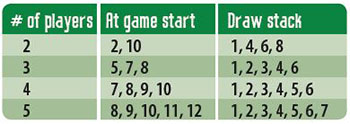
-
Use the factory tiles with a number on the back that matches the number of players (e.g. take the tiles numbered "2-5" and "3-5" for a game with 3 players). Arrange the factory tiles as described in supplement B: "the market mechanism". Leave some space next to the storage board for the market.
-
Shuffle the 6 factory tiles with an X (one each per type) and randomly remove 3 from the game, placing these back into the game box. Place the other 3 tiles face up in the market area.
-
Shuffle the 8 energy price tiles face down and randomly remove 3 from the game, placing them back into the game box. Place the remaining 5 tiles in a face down draw stack. Place the energy price marker on space 1 of the energy price track (price: 1 Elektro).
Exception for the first game (Please do this!): before shuffling all of the energy price tiles, take one of the "0" tiles and place it to the side. Shuffle the remaining 7 tiles and remove 3 from the game.
Place the "0" tile on the top of the remaining 4 tiles and place them as a face-down draw stack. Placing the "0" at the top gives players an easier beginning in their first game, because the energy price will not rise at the end of the first turn. This extra preparation avoids the runaway-problem of an early leader. Experienced players should use the normal preparation.
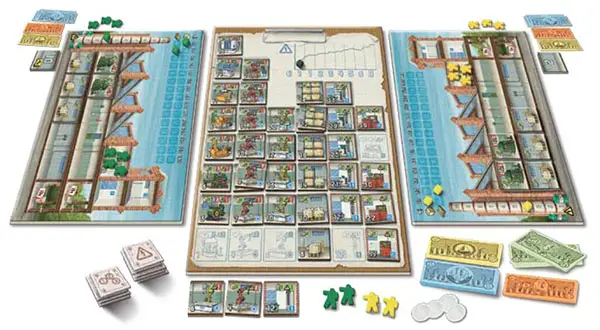
Game Play
The game is played over 5 rounds. Each round is divided into the following 5 phases:
- Auction the new player order
- Preparing the market
- Buying & placing factory tiles, tearing down factory tiles, and hiring seasonal workers
- Bureaucracy and new energy price
- Distribute income
The player order during the different phases depends on the player order tiles. The players either act in the forward order, starting with the lowest player order tile, or in reverse order, starting with the highest player order tile.
1. Auction the New Player Order
This phase is played in reverse player order. The player with the highest player order tile begins the phase.
Draw a new player order tile from the face-down draw stack for each player and place them face up in the playing area. The remaining two player order tiles are not used in this turn and remain face-down next to the playing area.
The player with the highest old player order tile chooses a new player order tile from the playing area and starts to bid for it with his available workers.
Important : during the game workers are considered as available if they are standing next to the factory boards and are not in the canteens or already used as a bid for a player order tile.
The minimum bid for the starting player is zero available workers, but he can begin his bid higher. In clockwise order, the other players either raise the bid of available workers or pass. If a player passes, he may not re-enter the current auction.
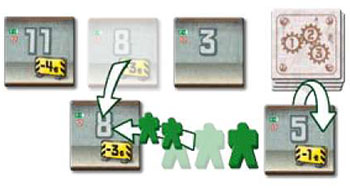
Continue the auction until only one player remains. This player takes the player order tile he won, places it face up in his play area, and places the number of workers he bid on the tile, where they remain and are not available anymore until the end of the turn. Afterwards he places his old player order tile face-down next to his new tile to show, that he already won an auction.
Note : these auctions are generally short as players do not have many available workers.
Important: A player must always have one available worker. The maximum bid must be at least one less than the total of his available workers.
After a player wins the auction for a new player order tile, he cannot bid for another tile in this turn. If the starting player won the auction for the chosen tile, the player with the second highest old player tile starts the next auction. If another player won the auction for the chosen tile, the same player chooses the next new player order tile to auction.
The last player gets the remaining new player order tile for a bid of zero available workers. He can, if he wants, offer one or more available workers (if he, for example, wants to have fewer factory tiles added to the market - see phase 2 "Preparing the market").
After every player has acquired a new player order tile, shuffle the draw stack together with the old player order tiles and place them back next to the playing area.
For all following phases of the round, the playing order is based on the new player order tiles acquired in phase 1 of this round. The player with the lowest player order tile starts the phase.
2. Preparing the Market
The central mechanism of factory manager is selecting the factory tiles for the market and purchasing these tiles for the factories. You find a detailed description of the market mechanism on supplement B: "the market mechanism".
Each player chooses one factory tile from any of the 6 columns for each of his available workers and places it in the market area (he must choose the cheapest from the column). On his turn, a player chooses all his tiles before the next player in turn order chooses his.
Note: during the first round, there are 3 additional factory tiles with an X in the market area.
A player must choose one tile for each of his available workers. He cannot decide to pass and choose less! The workers stay available for phase 4.
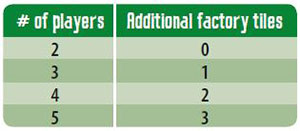
The last player in turn order (the player with the highest player order card) places additional factory tiles into the market area (see table).
Choosing these additional tiles is not mandatory. The player can deliberately place less or no additional tile at all into the market area!
3. Buying & placing factory tiles, tearing down factory tiles, and hiring seasonal workers
The player with the lowest player order tile starts this phase.
The player can use his available workers to buy a factory tile from the market area and place it into his factory floor OR to tear down a factory tile inside his factory floor. He takes all his actions before the next player in player order takes his turn.
Buying & Placing Factory Tiles:
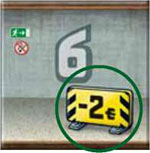
An available worker can buy any one factory tile from the market area. If the player has one of the player order cards numbered 4-12, he gets a discount on each single buy (small number on the player order card). The minimum price for a factory tile is always at least 0 Elektro.
The player takes the chosen tile, pays the price and places it into his factory floor. The player must place the tile on an empty space. Thus, if there are no empty spaces on his factory floor, he must first tear down a tile that is there to make room for the new tile.
Inside the factory floor the player places all machines, robots, and storage spaces. He can rearrange the tiles any time to get a better overview. The two special spaces control  and optimization
and optimization  can only be used for the matching factory tiles. Each player can only have one optimization tile and one control at the same time.
can only be used for the matching factory tiles. Each player can only have one optimization tile and one control at the same time.
A player may store an acquired tile beside his factory in order to place it in a following round. In such cases, the player may place these tiles in later rounds without the use of an available worker as the tile was originally acquired with the use of an available worker, if there is an empty space in the factory floor.
Placing tiles on the first 10 spaces of the factor floor is free. The player must pay 10 Elektro for each of the last two spaces the first time he places a tile on each space. If he later replaces a tile on one of these spaces, he does not pay the 10 Elektro again.
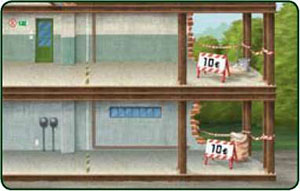
Tearing Down:
Instead of buying a factory tile, a player can use an available worker to tear down an already placed factory tile on his factory floor. He simply takes the chosen factory tile, places it next to the factory board and temporarily places the available worker on this tile.
After the turn, the player places the torn-down tile back in the box and his worker becomes available again. A player can tear down all placed factory tiles, including Optimization and Control.
The now vacant space can immediately be used to place a new factory tile that was bought by another available worker in the same turn (or a tile bought in a former turn and still lying next to the factory floor).
Hiring A Seasonal Worker:

After a player has taken all his actions with his active workers, he can hire up to 2 seasonal workers. Each seasonal worker costs 7 Elektro (minus a discount depending on the player order cards 4-12). If a player already employs seasonal workers and wants to keep them for another turn he needs to pay for them again at this time.
Seasonal workers are completely equal to normal workers.They can perform the same activities: operate machines (standing in the canteen), purchase turn-order tiles at auction, etc. The player has them for a complete round: until the end of phase 3 of the following round.
If a player decides to not pay to retain his seasonal workers, he must place them back into the general supply. If a player used one or both of his seasonal workers for bidding on a player order tile, he must place them back into the general storage, as well.
When all players have completed their turns, return all remaining factory tiles in the market to their spaces on the storage board, so that they are available for the next round. This is also true of the X tiles, if they are not bought.
4. Bureaucracy and New Energy Price
During this phase all players adjust their markers on the tracks of their factories and place the appropriate number of workers in the canteen. Additionally, they adjust the energy price.
Note: players must structure their factories in such a way that each always keeps at least one available worker. This can be a seasonal worker. Also, a player may actively operate only as many robots in his factory, as he has active machines. (
: only 1 robot per machine).
First, in player order, each player places all his workers in the space for available workers beside his factory. Next, each checks all factory tiles on his factory floor to update the 3 scales (production, storage, and energy consumption). Then each places enough workers into his canteen to operate all his machines.

Energy consumption: Each player adds all white numbers next to the energy symbol of the factory tiles inside his factory and subtracts the dark numbers. The final value is the new energy consumption of the factory. The minimal value of the energy consumption of a factory is always 1.

Production: Each player adds all the dark numbers next to the production symbol of all his factory tiles inside his factory. The sum is the actual production value of the factory.

Storage: Each player adds all the dark numbers his storage tiles. The sum is the storage space of the factory.

Workers in the canteen: Each player adds all white numbers next to the worker symbol of the factory tiles inside his factory and subtracts the dark numbers. The final value is the number of workers the player needs to place inside the canteen of his factory (a minimum of 0). The remaining workers are available in the next round and are placed next to the factory board.
Shut Down Machines And Robots:
In the following cases, a player must shut down machines or robots temporarily:
The player does not have sufficient workers in the canteen, in order to operate all machines, so he must shut down the "un-manned" machines.
The player built more robots than machines in the factory. Each machine can employ only one robot. Thus, the player must shut down the unused robots.
The player puts a "shut-down" marker as an indication of the temporary shutdown on the tiles that he has shut down..
The players decide each round which machines and/or robots will be shut down. As long as the above rules are followed, these can change each round as each shut down is considered temporary. The player can shut down factory tiles for tactical reasons (e.g. to have more available workers during the next turn).
Shut down machines and robots do not use energy. All values of a shut-down machine are not counted when adjusting the three scales, however, so the values of these scales can move both up and down. Also, the player must always have the required number of workers in his canteen.
New Energy Price:
draw the top-most energy price tile and adjust the marker on the energy price track accordingly. Move it a number of spaces equal to the number on the energy price tile (between 0 to 2 spaces).
Important: During the first round of your first game, as the tile with "0" will be the one drawn, the energy price stays at 1. Only during the second round the price may rise!
5. Income
During this phase, all players take their income from the bank. The income is based on the earnings (the lower number of the production or storage) minus the actual energy costs.
The earnings for a player is the lower of his production and storage tracks. To secure high earnings, players must increase both values during the game. A player with a production of 3 and storage of 8 will have an income of only 30 Elektro - the value of his production, which is lower than his storage.
The player determines the energy costs for his factory by multiplying the energy consumption by the actual energy price. During the game the energy costs will raise, so player will pay more and more for the energy!
The player subtracts his energy costs from the earnings. He takes his thus adjusted income in Elektro from the bank.
Example: at the beginning of the game, a player's factory has an income of 20 Elektro (although storage is already at size 3, he counts the value of smaller production). The energy consumption of the company is at 4. The energy price at beginning of the game is only 1 Elektro, so the player receives the player an income of 16 Elektro from the bank (income of 20 Elektro - energy costs 4x1).
Important: During the fifth and final round, the income of all players is doubled!
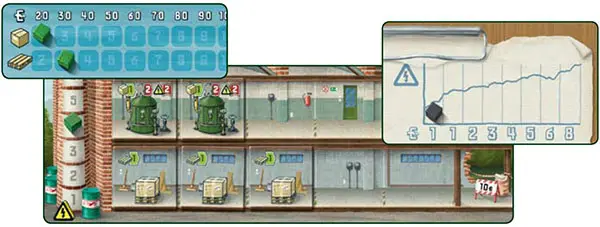
End of the Game
After five rounds the player with the highest amount of cash wins the game. In case of a tie the player with a higher income in the last turn wins the game.
Continue Reading
